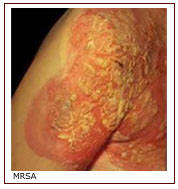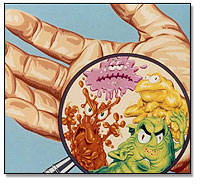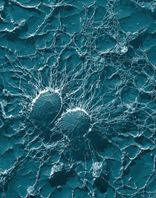Lurking Danger
Jun 1, 2008 12:00 PM
By Rick Markley
In an industry wrought with mortal danger, it is difficult for any single threat to rise above the competition. Not buckling up in an apparatus, cancer, lightweight construction, smoking, terrorist attacks, careless driving, poor fitness and bravado are part of the seemingly unending list of what kills and maims firefighters. But a particularly nasty brand of Staph infection is drawing an audience.
Part of what is elevating MRSA, or Methicillin-resistant Staphylococcus aureus as it's properly known, is that there appears to be a lot more cases of it than originally thought, and the bug has a fondness for fire stations.
MRSA comes in two basic varieties: community-acquired and health care-acquired. A study published in the Journal of the American Medical Association says that hospitals have been reporting MRSA since the 1960s. Community-based MRSA was first reported in 1981 among drug users in Detroit. In 1997, four children in Minnesota and North Dakota died from MRSA-related illness.
Kelly Reynolds, an associate professor at the Mel and Enid Zuckerman College of Public Health with the University of Arizona, says that there were nearly 370,000 hospital stays related to MRSA in 2005, doubling the 2001 figure.
The JAMA study looked at invasive MRSA statistics in nine cities between July 2004 and December 2005. From that, researchers made nationwide MRSA predictions. They estimated that there were 94,000 cases of invasive MRSA during that time and nearly 19,000 deaths, about a 5% mortality rate.
“This is greater than the number of deaths we experience from HIV and related complications,” Reynolds says. The Centers for Disease Control and Prevention recently called MRSA a national health crisis and, she says, it definitely fits the definition of an emerging infectious agent.
There are two reasons for MRSA's growth of late, Reynolds says. One is the bug itself; it is changing and becoming more resistant to antibiotic treatment. Another reason is the medical community, which has begun diagnosing MRSA more often because it is now on the lookout for the infection.
Reynolds says that the community-acquired MRSA tends to be more aggressive but easier to treat, whereas the hospital-acquired MRSA is less aggressive but more difficult to treat. She also says that some researchers believe that soon there will be one merged strain that takes on the worst characteristics of both.
Merger or not, the problem for the fire service is that its members move frequently between the community and health-care facilities, exposing them to both strains. MRSA is passed easily from person to person and from surfaces, such as tables and chairs, to humans. And depending on the surface, MRSA can survive for as long as two months. It even can survive for weeks in dust.
Staph bacteria will colonize naturally in the nasal passages of normally healthy people who display no adverse symptoms. This is the case for about 30% of the population, Reynolds says. In about 8% of those people, the Staph becomes MRSA.
MRSA tends to appear first as a spider bite or pimple. It is a boil that is very sore and will progress rapidly into an abscessed infection, Reynolds says. In two to four days it can enter the bloodstream and deeper, soft tissue. When it reaches that stage it is particularly difficult to treat.
For the Tucson (Ariz.) Fire Department, the threat of MRSA is more than statistics and theory. One of its chiefs has been fighting MRSA for two years. Deputy Chief Ed Nied says the chief nicked his elbow on an airplane. A day later that became infected; three days later he was found nearly unconscious at home and rushed to the hospital.
“He had subsequent surgery to remove a good portion of the muscle tissue and bone from his elbow,” Nied says. That should have been the end of it. “Eight months later it reappeared as a mass on his upper chest. That needed to be surgically removed as well.”
Last summer a Texas firefighter became what is believed to be the first firefighter to die from MRSA complications. In that case, Nied says, the firefighter experienced pain in his back and had a low-grade fever. The doctors didn't suspect MRSA and treated the firefighter for general infection and injury. However, the deep-seated MRSA infection tragically led to organ failure. In spring 2007, a Texas paramedic died of what many believe was MRSA; no official findings have been released, Nied says.
This prompted Reynolds and Nied to undertake a study to learn the extent of MRSA infestation in fire stations. Reynolds served as the study's principal investigator.
Some of the early MRSA infections were found in athletes, she says. That led to speculation that locker rooms and exercise facilities were a conduit for passing MRSA. Given the sweat, humidity and improperly disinfected surfaces, it seemed the natural breeding ground for Staph.
“I did a study of 18 [Tucson] gyms and did not find one MRSA deposit on any workout bench, any of the gym equipment, the weights, nothing,” Reynolds says. “That's why we did the study in the fire stations; we wanted to see what environment was heavily exposed.”
For this study, they went through Tucson's fire stations and sampled everything to find two things: a common, harmless bacteria that indicates general levels of hygiene, and MRSA. Everything firefighters touched — from ambulances to turnout gear to doorknobs to keys to the television remote control in the day room — was swabbed for bacteria, Nied says.
“We found it in places that we didn't think we would, and we didn't find it in places that we thought we would,” he says.
MRSA did not grow in warm, moist environments as the researchers thought. This, they believe, is because MRSA cannot compete with the other forms of mold growing in those environments. Where they did find it was on dry surfaces that were difficult to disinfect, like towels and carpeting. One of the “hottest” objects was the television remote because it is often touched and rarely cleaned. That MRSA is in fire stations is clear; how it got there is not.
“We can't say for sure if it was brought into the station from a patient, or whether it was from someone's child who played [someplace like] Chuck E. Cheese's last night,” Nied says. “You just don't know. This thing is out there and it is in the public.”
“Twenty percent of all the couches [cloth or fabric-covered] we sampled tested positive for MRSA; every time we found Staph, it was MRSA,” Reynolds says. “We never got MRSA in the fire trucks; the fire trucks are sparkling clean.”
They also are made of hard, often steel, surfaces, which are difficult for MRSA to cling to. And this, Nied and Reynolds say, is key to keeping firefighters safe from MRSA at the station. They advise replacing cloth surfaces with hard surfaces wherever possible. This means pulling up the carpeting in favor of concrete, wood or some other hard flooring. It also means replacing fabric-covered furniture with couches and chairs covered with cleanable material. In Tucson, the furniture is being reupholstered with a leather-like material that can withstand disinfectants like bleach and other harsh cleaners, yet is soft to sit on. It means replacing kitchen counters and tables with stainless steel. Softer surfaces, such as Formica, plastic and wood, will develop grooves from being cut on; these grooves will harbor bacteria. Reynolds recommends saturating those surfaces with disinfectant.
How cleaning agents are used is another key to controlling MRSA. Reynolds says that too often cleaning products are not left on the surface long enough to disinfect for MRSA. Depending on the product, the time it needs to be on the surface to kill MRSA is usually between four and 10 minutes.
“Whatever product you choose, make sure you follow the label very closely,” she says. “Make sure it is labeled as a disinfectant, which means that it does kill bacteria. If you have dirt, blood or feces in the environment, you need a longer contact time.”
Fire departments want a fast and effective cleaning agent because the personnel will not have time to let a surface soak for 10 minutes, Nied says. “Our goal was to find one magic bullet, and we haven't found that yet.”
The good news, Reynolds says, is that disinfecting surfaces to kill MRSA knocks out all other types of bacteria.
Making sure the station has positive air pressure compared with the apparatus bay is another way to control MRSA's spread. Nied says there is research showing that hospitals cut the incidents of infection by regularly filtering the air.
“I don't know how true that is,” Nied says, “but we need to start looking at that from the perspective of a fire station. These things are not cheap.”
As with air, turnout gear can carry MRSA and it must be confine to the work area. On cold nights everyone likes to step out of bed and right into turnout pants, Nied says. The department also must comply with the National Fire Protection Association's turnout gear cleaning standard, NFPA 1581. Regulating turnout gear storage and cleaning might be simple enough, but station boots and uniforms are another matter.
A firefighter or paramedic might kneel on a patient's carpeting to take blood pressure, return to the station and walk through the day room and bedroom wearing the same boots and pants. It is easy to transfer this stuff around the entire station, Nied says. But he doesn't have an answer to that problem.
One problem that fire departments can address is keeping the station wear at the station and properly laundering it. This reduces the risk of carrying MRSA from the fire station to the family. Nied says one Tucson firefighter developed a rash on his neck thought to come from a seatbelt; instead it was MRSA.
“He took his equipment home and washed it and his 14-month-old daughter came down with the same thing. We don't know if she got it from his uniform or from touching his neck, or what. But the bottom line is that this stuff will live a lot longer on your uniform than it will in a warm shower.”
One important aspect of laundering is using a dryer. Despite MRSA thriving in dry places, a clothes dryer running for at least 28 minutes on a high-heat cycle will kill MRSA. However, the energy-efficient cycles do not generate the heat needed to kill bacteria, Reynolds says.
“It wasn't that long ago in hospitals that nurses in the burn units would shower before going home, shower when they came to work and change into sterile scrubs,” Reynolds says. “They didn't bring anything to their patients; they didn't bring anything home.”
To reduce the risk of exposure, Tucson has made a few operational changes, Nied says. One change starts when a call comes in to the 911 center. Dispatchers now ask if the patient has a cough, fever or any known diseases. If the answer is yes to any of those, first responders go in wearing gloves, goggles and masks. Responders also wear this added protection when called to any of the department's identified high-risk environments, such as nursing homes or prisons. Another change the department made is limiting how many responders are exposed to potentially hazardous situations.
“It's the same thing with having 12 people in a bedroom fire; you don't need 12 people in a bedroom fire,” Nied says. “Most of the time we sent six people to a sick person call. You don't need all of them near the patient — in that 6- to 3-foot range where you can have issues.”
Hand-washing is one of the simpler ways to halt MRSA's spread. According to CDC, hands are the main mode of transmitting MRSA. And Reynolds says there is no need to go in for more expensive antibacterial soap; bar soap is equally effective. It is the scrubbing action that removes MRSA; antibacterial soap doesn't kill bacteria, but it does keep it from multiplying. She does caution against sharing hand towels, a surface hospitable to MRSA and other bacteria. Hand-sanitizing liquids are effective in a pinch, but no substitute for old-fashioned soap and water, she says.
Nied says one way to encourage hand-washing and keeping contaminants out of communal areas is to have washing sinks in the apparatus bay. If budgetary constraints prohibit running plumbing, place disinfectant hand-gel dispensers at the access points between the bay and the station. In Tucson, they've added signs letting firefighters know that the bay area is dirty and the station is clean.
“It is a gentle reminder not to bring the stuff in here, to use the hand sanitizer before using the door,” Nied says.
To clean up fire stations will require changing behavior, and in some cases changing attitudes. To help, Nied and Reynolds are trying to develop a Web-based MRSA education course that will be free and offer certification credits.
These are big changes to fight off a microscopic-sized killer in an environment teeming with danger. It may not come easy, but if it does, it is bound to have a large effect on the fire service.








